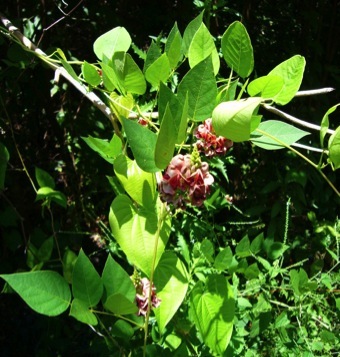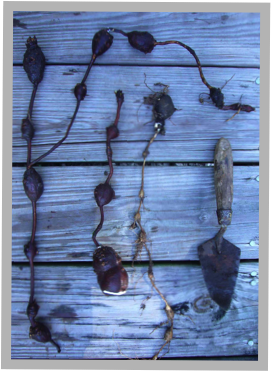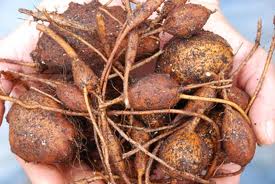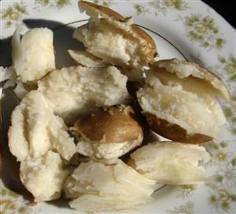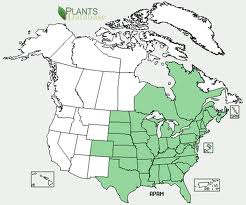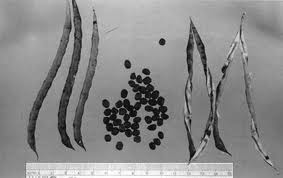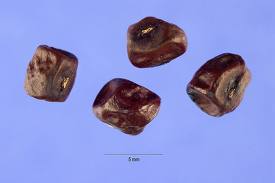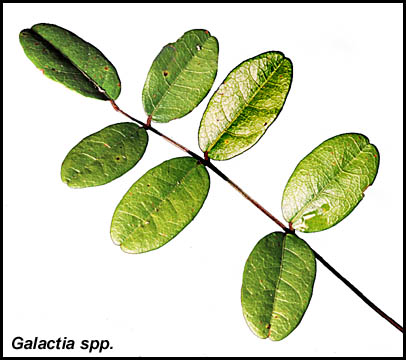Groundnuts: Dig ’em
I will never forget the first time I dug up Apios americana, groundnuts. I got poison ivy for the first time, too. Oddly it showed up in the crook of one elbow, then the next and then behind both knees. Fortunately it took 24 more years before I got my second case of poison ivy.
Groundnuts were highly esteemed by the first European colonists. But, their two-year growth cycle kept them from becoming a commercial crop, and now only foragers enjoy them though there is some interest in going commercial with them and they have been under agricultural study. Groundnuts are a prime wild edible that’s hard to misidentify. They’re like beads on a string except they are are larger and farther spread out, with the spacing irregular. The “string” can also branch off. But, once you find the string you are on to them and all you have to do is dig them out of the other roots. To find them I look for the vine climbing bushes and trees. It is unmistakably in the pea family. The vine can grow up to 20 feet a year. It’s thin, about an eight of an inch through, covered with fine hair, and tough for its size. The leaves are pinnately compound, sometimes folded in the midrib, and have three to nine two-inch leaflets with no teeth (five leaves are the most common.) The flowers are lavender to brown and fragrant, similar to lilacs some say, some say violets. Franky I think their aroma is not pleasant. When in blossom the vine is unmistakable between the color and shape. And of course, the root arrangement makes it nearly impossible to misidentify. Incidentally, it is the preferred plant for the Silver-Spotted Skipper so if you can recognize one of those, follow it.
The flowers are edible raw or cooked and the seeds are edible cooked, shelled first. Some writers say the tubers are edible raw but that only tells me they never tried to eat one raw, or coped with the gas that produces. Groundnuts have a bitter latex in them and should be cooked first. They also have some “anti-nutrition factors” including protease inhibitors which cooking neutralizes. I prefer to boil them first and then use them otherwise, such as for frying. Groundnuts definitely taste better when they are hot. Their texture and flavor degrades as they cool though they can be warmed up again. Groundnuts can be pea size to baseball size, smooth or lumpy. Most of the ones I find look like dark brown lumpy eggs. First year groundnuts are light yellow to reddish brown, and small. Second year, larger, darker, coarser. All are edible and peel like a tough potato. Groundnut also contains genistein, a known anti-carcinogenic compound. The Indians made a plaster out of it (cooked) for external cancers.
The groundnut was a very important food for the Indians. Some mixed it with acorns. Each tribe had a different related name for it. The Powhtan called it ouhpnhhauk which phonetically became ohpen. The Delaware Indians called it hopenis, the Fox, ahpenya, the Menomini, ophen, the Ojibwa, oppin, the Penobscott, ppan (that is not a typo) and the Shawnee peneeakee. Some French-speaking Canadians still call it penacs. In fact, Sag Harbor on Long Island got its name from groundnuts. The local Indians, the Metoac Algonquins, abandoned the theme of the rest and called them sagabon. It was also called Indian Potato from about 1626 on, along with many other roots. Then it was Indian ground nut, then groundnut and by 1787, Apios americana. Apios (AH-pee-os) is Greek for pear, because they can be slightly pear-shaped, and americana (ah-mer-ree-KAY-na) means American.
The groundnut grows throughout eastern North America west to Colorado. It likes crowded wet areas, usually near rivers, streams, and lakes. If you see Elderberries there is a good chance there are groundnuts there. Poison Ivy also likes that environment so beware. They can be dug any time of year, and are usually just under the surface. Start where the vine enters the earth near a bush. That’s usually where the largest tubers are, but that is not always true, and roots can crisscross like cattail roots do. First year tubers peel easily, second year are more stubborn. Cut out any dark spots. Also look for exposed ground nuts after river flooding. In Northern states they come out in June/July and are gone by September. Here in Florida they are flowering by late spring and carry on until late fall. In fact, the first time I found one I was wandering around a stream and smelled an interesting fragrance and saw the ruddy blossom. That exact spot is now covered with a huge house.
The tubers can be up to 17% protein and have similar amino acids to beans, the predominant amino acids being aspartic acid and glutamic acid. The seeds can have as much as 25-30% crude protein. The favor to me is like a yam (Dioscorea not Ipomoea) with the texture of boiled turnip. Many, copying botanist Merritt Fernald from a book older than me, Gray’s Manual of Botany, report it has a turnip flavor. I think that is an exaggeration, but I can understand why they say that. Once boiled groundnuts can be used like potatoes but it is not a potato flavor nor does it have the starchiness of a potato. I enjoying slicing up boiled A. americana and frying them. Boiled then roasted groundnuts can be ground into a flour. As always, try a little first and make sure it agrees with you. Some people have a bad reaction to the groundnut, causing them to lose fluids from both ends. I suspect that comes from under cooking the latex or an allergy. Be careful. Try a little first.
One warning, some people have eaten groundnuts for years with no problem and then have a reaction to it. It is not common but it does happen. A few, perhaps five percent, have an immediate reaction to it. Whether it is an allergy or the way the groundnut is grown is not known. So, be careful.
There is actually an Apios in China and two more in North America. There used to be more here but botanists think most are a variation of the A. americana. The other one is A. priceana. It likes open hardwoods forests, rocky, drained soil, and only grows one large root and has pink to white flowers. Called “traveler’s delight” is is found sporadically in Mississippi, Alabama, Tennessee, Kentucky and southern Indiana. Named after Sarah France Price, its discoverer, it is “endangered” because of loss of habitat. Please don’t eat it should you find one. (I have two videos about the groundnut. Here’s the first one, and the second one. )
One word of caution: Don’t confuse the groundnut with the non-edible Milk Pea. Our local our Milk Pea, Galactia elliottii, has leaflets of five to nine though five and seven are common like the groundnut. However the Milk Pea likes dry ground, usually pinelands or open sandy soil. More so the Milk Pea has white flowers, sometimes tinged with pink. Its leaves also have round tips whereas the Groundnut’s leaves are pointed. There are 11 different species of Milk Pea, many of them are difficult to tell apart, some with pink blossoms and purple flowers. The most common milk peas grow from Texas to Florida and north to New York and Kansas. Also don’t confuse it with Vigna luteola, the Hairy Cowpea, which has leaflets of three and yellow blossoms. However the Hairy Cow pea blossoms and seeds can be eaten cooked.
If you want to grow ground nuts they can be started from seed or tuber. Oddly, while one finds groundnuts in water-logged soil they grow best under cultivation in well-drained soil. To quote Purdue’s new crop proceedings of 1990:
“Most of the research involving cultural practices has been directed towards developing techniques to screen large numbers of plants. Direct-seeding has presented problems. Seeds may take 10 to 30 days to germinate. Seedlings are small and early seedling growth is not vigorous. Seedling death, presumably from insects or diseases, has plagued this technique for starting apios. The most satisfactory method has been to start plants in peat pellets. After germination, when the shoots begin elongation, the plants are pinched back to the first leaves. This prevents the plants in a flat from twining on each other, allows for better root development prior to planting, and permits plants from slower germinating seed to reach sufficient size to transplant. However, pinching back carries a potential risk of spreading disease among the seedlings. Weak seedlings can be discarded at this stage.
Tubers are planted intact. The buds that give rise to the shoots and rhizomes occur at the distal end of the tubers. The potential of dividing tubers into sections prior to planting needs evaluation. Generally the larger the tuber, the more rapid the early growth.
Seeds may be harvested from the time the pods first begin to dry. If left on the vine too long some pods will shatter Tubers are harvested after frost. Since most of the plants are different (originating from seeds), the tubers are harvested with a shovel to insure that genotypes can be evaluated individually. Fortunately, tubers can remain in the soil for extended periods without rotting even under water-logged conditions, thus allowing an extended harvest period.
Although apios in its native habitat is found growing on water-logged and acidic soils (Reed and Blackmon 1985), observations under field conditions indicate that apios grows best on well-drained soils. A pH less than 5 or as high as 8 may also be detrimental to growth. Adequate moisture is important, but excess moisture encourages longer rhizomes.”
Groundnut and Olive Stew
8 to 16 oz boiled groundnuts
one can or about 16 oz olives (California or Kalamata, reduce salt if using Kalamata olives.)
One can or about 16 ounces chopped tomatoes
One large onion chopped
Garlic to taste, I add several whole cloves.
Broth or water to cover. If you use commercial broth compensate for the added salt.
Olive oil for flavoring, approximately 1 tablespoon, and pepper to taste
Optional: One lamb shank or about 12 ounces of meat. Cuts that respond to slow cooking are the best
Salt to taste
First cook large-cut groundnuts in a lot of water until done, about 40 minutes. Drain. Put all of the ingredients into a pot and cook until done. If not adding meat, cook until the flavors marry, usually about an hour on medium heat. If cooking with meat, cook on low heat until it is tender, two or three hours. Serve with hearty bread and red wine.
Green Deane’s “Itemized” Plant Profile
IDENTIFICATIOIN: Climbing vine to 20 feet, pinnate leaves with 3-5-7-9 leaflets about two inches long, five leaflets is the norm. The flowers are red-brown to purple, very fragrant, pea-like wings and keel. Seeds in a pod. Roots like beads on a string.
TIME OF YEAR: In most climes blossoms in summer, sets fruit all the time. In Florida blossom sooner and sets longer.
ENVIRONMENT: Where you find Elderberries you can find groundnuts. They like the moist soil near streams and bodies of water, places usually populated with poison ivy and mosquitoes.
METHOD OF PREPARATION: Peel and boil like you would a potato then use like a potato, or slice raw and fry. But they must be cooked for raw they can be bitter and contain latex. Do not cook in an aluminum pot. Beans are edible when shelled and cooked. Rat studies show they thrive far better on cooked groundnuts than raw groundnuts. Tubers can be stored up to 15 weeks in the refrigerator without any significant loss of quality. I prefer to boil them first and then use them otherwise, such as for frying.
HERB BLURB
Dep. of Plant Pathology, Univ. of Missouri, Columbia, MO: American groundnut (Apios americana Medikus) is a nitrogen fixing legume that produces edible tubers and seeds. Even though studies have been conducted on the quality of tuber storage compounds, very little is known about compounds that could have beneficial effects on human and animal health. The objective of this study was to investigate the presence of genistein in the tubers. The nodC gene of Rhizobium fredii Scholla and Elkan USDA191 that had been fused with ß-galactosidase was used to detect the presence of genistein in A. americana tubers. The flavonoids from A. americana tubers were purified by C18 reversed-phase HPLC. The HPLC profile revealed nine UV absorbing peaks. Among them, Peaks 6 and 8 activated the nodC-lacZ gene fusion about two fold, while the bulk of the inducing activity was associated with Peak 9. The compound in Peak 9 and authentic genistein standard had identical retention times. When A. americana tuber flavonoids were spiked with an authentic genistein standard, Peak 9 coeluted with genistein. In addition, a peak at m/z 271, corresponding to the protonated genistein, was found when the HPLC Peak 9 was analyzed by electrostaticspray mass spectrometry. The results of this present investigation indicate that A. americana tubers contain the isoflavone genistein. The discovery of genistein in A. americana tubers should rekindle interest in this legume as a food crop since genistein has been shown to reduce the incidence of various forms of cancer. Contribution from the Univ. of Missouri Agric. Exp. Stn., Journal no. 12703, Columbia, MO 65211. Received for publication November 13, 1997.

